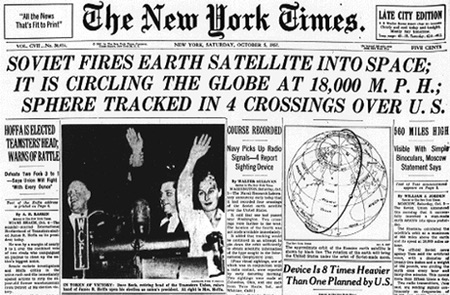Redefining NASA: part 2The Cold War origins of NASAby Zach Miller
|
| These prideful space activities actually originate in a different kind of nationalism, the kind that surrounds war and conflict. |
Many would agree that space represents the unity of humanity, a notion embodied in the emotionally moving image titled “Earthrise.” A simple picture of a small, pale blue dot rising over a bleak lunar horizon is enough to make even the greatest humans feel like a drop of water in an endless sea. Space activity has brought together nations and united people behind ambitious causes. The Apollo-Soyuz Test Project in 1975 symbolized cooperation between bipolar enemies, and the International Space Station of today represents even broader international cooperation. Peaceful cooperation lies at the foundation of the legal framework set forth in the Outer Space Treaty.
On a national scale, pursuing space endeavors has the same unifying effect, such as the nationalistic pride felt by nearly every American upon seeing the American flag on the surface of the Moon in 1969. However, these prideful space activities actually originate in a different kind of nationalism, the kind that surrounds war and conflict. It is no coincidence that space and defense are often categorically lumped together. National defense has always been (and still may be) at the nexus of space activity, and the famous state institutions that have accomplished so many incredible things in space originate in a war-focused birthing ground. For this reason, space activity has historically been conducted by national space agencies.
The Jet Propulsion Laboratory (JPL) is one of the birthplaces of modern spaceflight. Its engineers, through a combination of ingenuity and innovation, spurred great feats accomplished during the space age. JPL itself rose from humble civilian beginnings, but once it was officially institutionalized, it was permanently and inherently tied to the government.
In the mid 1930s, a group of students at the California Institute of Technology began to experiment with rocket science, which was then regarded as a fantasy rather than a discipline. Professor Theodore von Kármán, a Hungarian physicist at Caltech, along with Frank J. Malina, a graduate student there, spearheaded an avant-garde group dedicated to experimenting with rockets. This group formed underneath the umbrella of the California Institute of Technology’s Guggenheim Aeronautical Laboratory (GALCIT) and began to test rockets with the gradual financial support of Caltech. GALCIT served as the research base for the future establishment of JPL (Koppes).
Like many research organizations, GALCIT was limited according to the little amount of funding it received from Caltech. In 1943, however, the laboratory would begin to flourish under wartime pressure. The Army Air Force sent Kármán top secret photos of German rocket launchpads, seeking information as to the technology behind German rocketry. After a few more photos were sent to Kármán, he was able to determine that the capability of German rocket science surpassed that of the United States and its Allies, prompting the Army to establish a rocket development research division. GALCIT was then consulted for use of its engines. Kármán assembled a brief proposal with theoretical and practical missile development goals and, after a few branches of the Army refused it, the Army Ordnance Corps approved it in 1944. Kármán’s proposal held the title JPL-1, an acronym for Jet Propulsion Laboratory, and thus JPL was conceived from the demand for weaponry during World War II. By the end of the war, the newly-formed JPL was operating almost entirely in secret, researching weapons and rocketry theories. But when NASA came to be in 1958, the direction of JPL would shift from the subjects of rockets themselves to the payloads delivered by rocket propulsion (Koppes).
In 1957, Sputnik shocked the world when it became the first artificial satellite. Impacted more extremely than anywhere else because of vicious Cold War tension, the United States fell behind in its space race with the Soviet Union, prompting a frenzy of new initiatives and efforts to funnel more money into research. In fact, “the space programs of the cold war adversaries formed a symbiotic relationship -- a race in which each competitor spurred the other forward.” (Portree)
| Thus, the famous national space agencies that have inspired such immense feelings of hope, wonder, and unity were actually born out of wartime national security. Today, however, their missions are much larger in scope. |
This mutual encouragement, however, was much more negatively reinforced than it was positive. Though Sputnik posed no physical military threat, the psychological effect of putting the first satellite into orbit significantly influenced upon American society. Some American citizens believed that the Soviets had the capability of launching long-range missiles that could carry atomic weapons across oceans and continents, a thought that struck fear into American society. President Dwight D. Eisenhower downplayed the significance of the satellite, but could not allay those fears. The United States scrambled to assemble a national space agency. To make the matter more pressing, the Soviet Union successfully launched Sputnik 2 a month later. In a short time, the Russians had placed two artificial objects in Earth orbit with no response from the United States (Koppes).
 A New York Times front page reporting the launch of Sputnik. |
In the scare following the launch of the Sputnik satellites, the US Army Ballistic Missile Agency contracted JPL to design, build, and operate the payload of one of their missiles, and at the end of January in 1958, Explorer 1 became the first American satellite to be placed into orbit. The success of this operation sparked a frenzy to put more satellites into space, initiating the Explorer series that attempted four more launches.
Even though the United States had begun to catch up to the Soviets in the Space Race, there was still a great amount of pressure from the American people for the US government to continue to fund advancements in aeronautics technology. As a result, the US Congress formed the Committee on Space and Aeronautics in February of 1958, a group that created the framework for a national space agency. The project culminated successfully in October as the National Aeronautics and Space Administration formally started operations. JPL was quickly absorbed into NASA as one of its institutes, and thus began the legendary relationship between the two organizations, both born out of wartime demands for weaponry and ballistic technology (Koppes).
Thus, the famous national space agencies that have inspired such immense feelings of hope, wonder, and unity were actually born out of wartime national security. Today, however, their missions are much larger in scope. Though national defense is a critical aspect of space activity, it is not always a central theme; additionally, globalization and international organizations limit the use of space as a medium for national defense. New, powerful commercial actors present revitalizing concepts such as profitability and competition. Because the characteristics of the space industry have changed dramatically since its inception, NASA must attempt to redefine its purpose and find its niche in the space industry. Its success as a governmental agency, as well as the success of the United States in exercising its interests in outer space, depends on NASA adapting to a new era.
The third and final article in this series will be an argument piece attempting to broadly flesh out how NASA should reorganize its priorities as well as substantiating claims from previous articles.
References
Koppes, Clayton. JPL and the American Space Program. New Haven and London: Yale University, 1982. Print.
Portree, David S. F. NASA’s origins and the dawn of the space age [electronic resource]. Washington, DC. NASA History Division, Office of Policy and Plans, NASA Headquarters.1998. Government Printing Office Catalog, EBSCOhost (accessed November 6, 2015).
